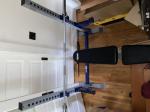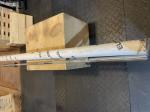High Intensity Training
High Intensity Training (HIT) can be summed up as follows: "Brief, Infrequent and Intense."
This type of training is perfect for the natural bodybuilder who needs ample time to recover after strenuous workouts. There is more emphasis on rest and recovery in the HIT philosophy than in most other weight training methods.
Note: You should have at least six months of lifting experience before you try High Intensity Training. This is to take into consideration the "newbie gains" most beginning weight lifters experience. Eventually, the gains will slow from four-five day routines as you become overtrained. Especially if you are a "mature" bodybuilder (age 40+).
The whole concept of this type of training is to hit your muscles as hard as you can in a short period of time. Your rest time in-between sets are minimal plus you are taking every set to failure and past utilizing forced reps and rest/pause techniques.
Each set should be done to failure. What is failure? When you no longer can do another rep in good form. When you no longer can do another rep, continue with the rest/pause technique. Take the amount of weight you can normally do 10 times, do ten straight reps and then continue to go until you reach 20, resting as much as 10-20 seconds between the last ten reps. I would only do this technique on one exercise for each workout session. Squats are brutal using this technique.
In most HIT routines you are only doing one set per exercise, and you can give it everything you got. When you are doing three sets of 10 reps you are forced to hold back (whether consciously or unconsciously) on early sets so you can make it through three sets at a certain weight.
Reps are structured in this fashion: Since you are only doing one set of each exercise, every rep counts.
You need to add weight or reps to every exercise session (overload principle). You take four seconds to lift the weight, pause two seconds at the top (static contraction) and four seconds down (negatives). On certain exercises such as the bench press, hold the two second static contraction right before you lockout your arms. This puts all the stress directly on the muscles rather than on the bones.
The next workout should not be performed until the body is COMPLETELY recovered from the previous workout (which may take days depending upon your age and recovery abilities).
Many HIT routines consist of full body workouts completed once a week. Here's an example:
Full body warm-up, (a medicine ball is good for this) then:
Leg Press, 1 set X 12 reps or 20 rep rest/pause squat
Hamstring Curl, 1 X 12
Bent Rows, 1 X 12
Shoulder Press, 1 X 12
Good morning, 1 X 12
Bench Press, 1 X 12
Shrugs, 1 X 12
Curls, 1 X 12
Skull crusher, 1 X 12
Calf Raises, 1 X 12
Ab's, 1 X 12
Rest at least three days or preferably more before repeating.
Of course not all HIT routines are full body workouts completed only once a week. While researching HIT routines, I found the following one that utilizes a varying rep range and also considers the fact that we have different muscle fiber types. The routine below is more of a HIT/split body part routine.
Very well written and thought out!
Gerry Hitman's Rep-Range H.I.T. workout program.
This is a High Intensity Training routine that I put together that takes into consideration the reality that we have different types of muscle fibers. This is addressed with the use of different rep-ranges and rep-speeds that have been shown to induce maximum stimulation of all types of muscle fibers.
Further, this routine is based on the logical idea that weight training should be A. Brief, B.Intense, and C. Infrequent.
Frequency:
This is not set in stone however and each individual needs to assess his/her own recovery ability. Rest days can be added or subtracted as needed, but the basic principle for frequency in HIT is to be recovered well enough to allow for growth and strength increases on a continual basis.
High Intensity weight training is very taxing and must therefore be brief and infrequent. The High Intensity workout will provide the needed muscle stimulation, but rest is required for recovery and growth. In HIT training, recovery accounts for 50% in overall importance with the other 50% being the workout itself, and this does not take nutrition into consideration which is also very important.
Here is what I am currently doing for frequency:
- Perform workout 1 (Monday) then take 3 full days rest.
- Perform workout 2 (Friday) - then take 4 full days rest.
- Perform workout 3 (Wednesday)-then take 4 full days rest and repeat.
After completing 3 cycles, finish workout 3 (Wednesday)- then take 11 days off which brings you back to work out 1 (Monday). The 11 day break given every 3 cycles, will allow for full recovery and repair of tendons and joints as well. You will come back stronger than ever and ready to beat your previous records.
Warm-up sets:
It is important that before you begin you're main or high intensity working set, you need to prepare the CNS (Central Nervous System) and warm up the target muscle group. On the first exercise for a muscle group perform at least 2 warm up sets; on the second and third (if applicable) exercise of the same muscle group, only the 1 @ 85-90% pre-working warm-up is needed.
For example on the first exercise in the 4-7 rep range your goal is to set your weights to reach positive failure somewhere within 4-7 reps. If you were doing a barbell bench press and set to failure at 300 Lbs., your first warm-up set would be 150Lbs @ 7 reps.
- First warm-up set of first exercise- Doing 7 reps with this (100% of the maximum number of reps) at 50% of working set weight.
- Then on the second warm-up set to fully prepare the CNS for the heavy set to come, use 85-90% of you working set total, in this case it would be around 250Lbs and perform 4-5 reps with this about 50% of the maximum rep total.
- Then perform the working set to failure in the target rep range.
Notice we are keeping our warm-up sets to the very minimum as we want to conserve as much recovery resource as possible for the high intensity working sets. Therefore on the remaining exercises for the same muscle group I recommend only performing 1 pre-working set and that at 85-90% of the working set weight and 50% of the maximum rep total for that exercise.
Rep speed-tempo:
- 4-7 rep range-This rep range is to directly stimulate the type 2A and 2B muscle fibers with the emphasis on the 2B's. With these it is recommended than an eccentric (negative contraction of about 3-4 seconds, followed immediately by an explosive concentric (positive) contraction. Therefore attempt to move the weight as fast as possible in the positive; it is a heavy weight so although you are attempting to move it fast it will not, due to the resistance. Take no pause in the contracted position, and a slow 3-4 second negative down then explode up.
- 8 through 15 rep ranges-These rep ranges will directly stimulate the type 1 through the 2B fibers with the emphasis on the 1 & 2A muscle fibers. I recommend all the rep-ranges in this program from 8-15 to be performed with a 2 second concentric movement, 1 second pause in the fully contracted position, then a 2 second eccentric (negative) movement.
Maintain good form throughout.
The HIT-MAN workout cycle
Workout 1. Chest/shoulders/ Triceps.
- Chest) Perform compound movement such as Incline dumbbell or barbell bench press-1 X 4-7 reps to failure (1 set).
- (Chest) Perform compound movement (flat barbell bench press for example), and set weight to failure in the 8-12 rep range (1set).
- (Chest) Perform an isolation exercise such as pec-deck or cable crossovers and set weight to failure in the 12-15 rep range (1set).
- (Shoulders) Perform compound movement such as standing barbell or dumbbell overhead presses, set weights to failure in the 4-7 rep range (1 set).
- (Shoulders) Perform compound movement such as Dumbbell or barbell upright row, set weight to failure in the 8-12 rep range (1 set).
- (Shoulders) Perform isolation movement such as dumbbell extensions or bent over fly's, set weight to failure in the 12-15 rep range (1 set).
- (Triceps) Perform compound movement such as dips, set weight to failure in the 6-8 rep range (1 set).
- (Triceps) Perform isolation movement such as V-bar press, downs or scull crushers, set weight to failure in the 10-15 rep range (1 set).
Workout 2. Back/Biceps/Forearm
- (Back) Perform compound movement such as Barbell or T-bar bent over row, set weights to failure in the 4-7 rep range (1 set).
- (Back) Perform isolation exercise such as straight arm cable press down, set weights to failure in the 12-15 rep range (1 set).
- (Bicep) Perform compound movement such as standing barbell curl, set weights to failure in the 4-7 rep range-(1 set).
- (Bicep) Perform an isolation exercise such as dumbbell concentration curls, set weights to failure in the 10-15 rep range (1 set).
- (Back) perform barbell dead-lift, set weights 1 rep shy of failure in the 8-12 rep range (1 set).
- (Optional) (Back/biceps): Close grip palms up cable pull downs or chin ups, sets weights to failure in the 6-10 rep range (1 set).
- (Forearm) Perform a set or 2 of barbell or dumbbell wrist curls to failure or close to it in the 8-12 rep range (1 or 2 sets).
Workout 3. Legs/abs
- (Quads) Compound movement such as Barbell or smith machine squats, may alternate with leg press machine. Set weights to 1 rep shy of failure in the 8-12 rep range (1 set).
- (Quads) Isolation-Leg extensions-Set weights to reach failure in the 12-15 rep range (1 set).
- (Hamstrings) Leg Curl machine, set weights to failure in the -1 X 4-7 rep range (1 set) then reduce weight and do another to reach failure in the 12-15 rep range (1 set).
- (Calves) Seated calve raises, set weight to failure in the 8-12 rep range (1 set). May perform another set to failure in the 12-15 rep range either seated or standing.
- (Abs) Perform a weighted abs exercise using an abs machine or weighted cable crunches set weight 1 rep shy of failure in the 8-12, rep range, then drop weight and perform another 8-12 reps again just shy of failure.
- (Abs) Leg raises (with weight if needed) to reach failure in the 18-24 rep range (1 set).
HIT training has many skeptics due to the fact of A. the frequency of the workouts and B the rep-range/speed involved. Lifters who do the standard of 3 sets of 12 reps, with eight exercises per workout session, and four to five days a week will never believe that a full body workout completed once a week will ever get the same results as their overtraining work out.
If you are an older bodybuilder (like myself), give HIT training a try. Allowing my body to fully recover has led to greater size and strength gains and has kept me motivated and looking forward to my next workout.
HIT training resources:
Clarence Bass Ripped Enterprises
Recent Articles
-
Bench Press Full Set
Jul 06, 22 01:48 PM
Weights/Bar/bench/clamps/safety bars,etc! Everything is included and is In VERY good condition! About 300lbs of weight along with a adjustable/removable -
Eleiko Olympic training bar
Sep 20, 21 02:39 PM
Bar has been used less than one year. It is in superb shape. Same bar new is almost $1,000 dollars. Selling for 800.00.I Have the tube to ship it. Razor4wolverines@yahoo.co -
Olympic weights
Jul 07, 21 05:35 PM
I have 395 pounds of weight Including the barbell. 4)45 2)35 2)25 2)10 4)5 4)2.5 contact: Guadron193@gmail.com









